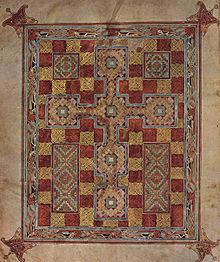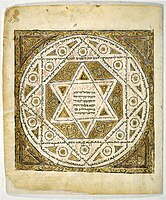
Celtic knots are a variety of knots and stylized graphical representations of knots used for decoration, used extensively in the Celtic style of Insular art. These knots are most known for their adaptation for use in the ornamentation of Christian monuments and manuscripts, such as the 8th-century St. Teilo Gospels, the Book of Kells and the Lindisfarne Gospels. Most are endless knots, and many are varieties of basket weave knots.

The Lindisfarne Gospels is an illuminated manuscript gospel book probably produced around the years 715–720 in the monastery at Lindisfarne, off the coast of Northumberland, which is now in the British Library in London. The manuscript is one of the finest works in the unique style of Hiberno-Saxon or Insular art, combining Mediterranean, Anglo-Saxon and Celtic elements.

The Book of Kells is an illuminated manuscript and Celtic Gospel book in Latin, containing the four Gospels of the New Testament together with various prefatory texts and tables. It was created in a Columban monastery in either Ireland or Scotland, and may have had contributions from various Columban institutions from each of these areas. It is believed to have been created c. 800 AD. The text of the Gospels is largely drawn from the Vulgate, although it also includes several passages drawn from the earlier versions of the Bible known as the Vetus Latina. It is regarded as a masterwork of Western calligraphy and the pinnacle of Insular illumination. The manuscript takes its name from the Abbey of Kells, County Meath, which was its home for centuries.

The Book of Durrow is an illuminated manuscript dated to c. 700 that consists of text from the four Gospels gospel books, written in an Irish adaption of Vulgate Latin, and illustrated in the Insular script style.
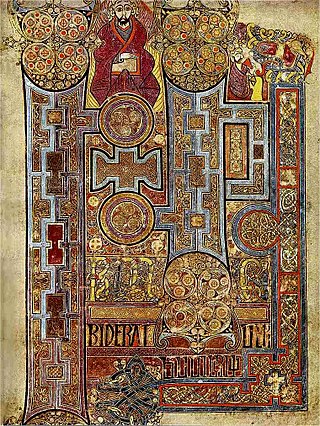
A Gospel Book, Evangelion, or Book of the Gospels, is a codex or bound volume containing one or more of the four Gospels of the Christian New Testament – normally all four – centering on the life of Jesus of Nazareth and the roots of the Christian faith. The term is also used for a liturgical book, also called the Evangeliary, from which are read the portions of the Gospels used in the Mass and other services, arranged according to the order of the liturgical calendar.
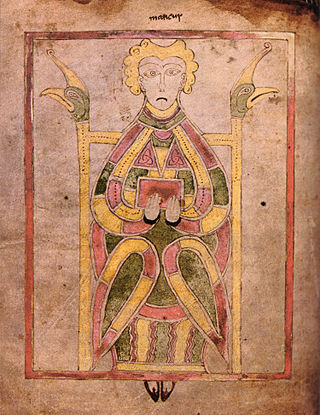
The Book of Dimma is an 8th-century Irish pocket Gospel Book originally from the Abbey of Roscrea, founded by St. Crónán in County Tipperary, Ireland. In addition to the Gospels of Luke and John, it has an order for the Unction and Communion of the Sick. The surviving illumination of the manuscript contains a number of illuminated initials, three Evangelist portrait pages, and one page with an Evangelist's symbol. The pocket gospel book is a distinctively Insular format, of which the Stowe Missal and Book of Mulling are other leading examples.

The Book of Mulling or less commonly, Book of Moling, is an Irish pocket Gospel Book from the late 8th or early 9th century. The text collection includes the four Gospels, a liturgical service which includes the "Apostles' Creed", and in the colophon, a supposed plan of St. Moling's monastery enclosed by two concentric circles.

Durham Cathedral Library, Manuscript A.II.10. is a fragmentary seventh-century Insular Gospel Book, produced in Lindisfarne c. 650. Only seven leaves of the book survive, bound in three separate volumes in the Durham Cathedral Dean and Chapter Library. Although this book is fragmentary, it is the earliest surviving example in the series of lavish Insular Gospel Books which includes the Book of Durrow, the Lindisfarne Gospels, the Lichfield Gospels and the Book of Kells.

The Durham Gospels is a very incomplete late 7th-century insular Gospel Book, now kept in the Durham Cathedral Dean and Chapter Library. A single folio of this manuscript is now in Magdalene College, Cambridge. Only two of the fully decorated pages survive: a Crucifixion and the initial to John, and both of these are in poor condition. There were probably originally evangelist portraits and carpet pages, as in other Insular Gospel books conceived on a similar scale. The book was produced at Lindisfarne and brought to Durham when the monks of Lindisfarne removed to Durham because of Viking attacks. The Durham Gospels were written by the same scribe who wrote the Echternach Gospels, now in Paris.
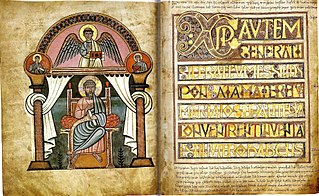
The Stockholm Codex Aureus is a Gospel book written in the mid-eighth century in Southumbria, probably in Canterbury, whose decoration combines Insular and Italian elements. Southumbria produced a number of important illuminated manuscripts during the eighth and early ninth centuries, including the Vespasian Psalter, the Stockholm Codex Aureus, three Mercian prayer books, the Tiberius Bede and the British Library's Royal Bible.

Evangelist portraits are a specific type of miniature included in ancient and mediaeval illuminated manuscript Gospel Books, and later in Bibles and other books, as well as other media. Each Gospel of the Four Evangelists, the books of Matthew, Mark, Luke, and John, may be prefaced by a portrait of the Evangelist, usually occupying a full page. Their symbols may be shown with them, or separately. Often they are the only figurative illumination in the manuscript. They are a common feature in larger Gospel Books from the earliest examples in the 6th century until the decline of that format for illustrated books in the High Middle Ages, by which time their conventions were being used for portraits of other authors.
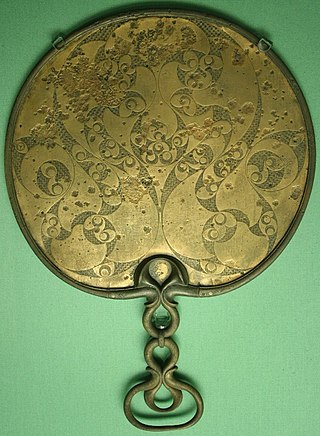
Celtic art is associated with the peoples known as Celts; those who spoke the Celtic languages in Europe from pre-history through to the modern period, as well as the art of ancient peoples whose language is uncertain, but have cultural and stylistic similarities with speakers of Celtic languages.

Migration Period art denotes the artwork of the Germanic peoples during the Migration period. It includes the Migration art of the Germanic tribes on the continent, as well the start of the Insular art or Hiberno-Saxon art of the Anglo-Saxon and Celtic fusion in Britain and Ireland. It covers many different styles of art including the polychrome style and the animal style. After Christianization, Migration Period art developed into various schools of Early Medieval art in Western Europe which are normally classified by region, such as Anglo-Saxon art and Carolingian art, before the continent-wide styles of Romanesque art and finally Gothic art developed.

Insular art, also known as Hiberno-Saxon art, was produced in the post-Roman era of Great Britain and Ireland. The term derives from insula, the Latin term for "island"; in this period Britain and Ireland shared a largely common style different from that of the rest of Europe. Art historians usually group Insular art as part of the Migration Period art movement as well as Early Medieval Western art, and it is the combination of these two traditions that gives the style its special character.
Lacertines, most commonly found in Celtic, Anglo-Saxon, and Insular art, are interlaces created by zoomorphic forms. While the term "lacertine" itself means "lizard-like," its use to describe interlace is a 19th-century neologism and not limited to interlace of reptilian forms. In addition to lizards, lacertine decoration often features animals such as birds, lions, and dogs.

In the visual arts, interlace is a decorative element found in medieval art. In interlace, bands or portions of other motifs are looped, braided, and knotted in complex geometric patterns, often to fill a space. Interlacing is common in the Migration period art of Northern Europe, in the early medieval Insular art of Ireland and the British Isles, and Norse art of the Early Middle Ages, and in Islamic art.

The Lindau Gospels is an illuminated manuscript in the Morgan Library in New York, which is important for its illuminated text, but still more so for its treasure binding, or metalwork covers, which are of different periods. The oldest element of the book is what is now the back cover, which was probably produced in the later 8th century in modern Austria, but in the context of missionary settlements from Britain or Ireland, as the style is that of the Insular art of the British Isles. The upper cover is late Carolingian work of about 880, and the text of the gospel book itself was written and decorated at the Abbey of Saint Gall around the same time, or slightly later.

Insular illumination refers to the production of illuminated manuscripts in the monasteries of Ireland and Great Britain between the 6th and 9th centuries, as well as in monasteries under their influence on continental Europe. It is characterised by decoration strongly influenced by metalwork, the constant use of interlacing, and the importance assigned to calligraphy. The most celebrated books of this sort are largely gospel books. Around sixty manuscripts are known from this period.
Rachel Moss is an Irish art historian and professor specialising in medieval art, with a particular interest in Insular art, medieval Irish Gospel books and monastic history. She is the current head of the Department of the History of Art at Trinity College Dublin, where she became a fellow in 2022.
